
The University of Western Ontario
2000-01 Operating Budget
April 17, 2000
Table of Contents:
A. The 2000-01 Budget Planning Model
B. The March 2000 Grant/Tuition Announcement and Resulting Budget Context
C. The 2000-01 Quality Improvement Plan
D. Update on Current Year’s Budget (i.e. 1999-2000)
F. Budget Allocations to Faculties
H. Budget Allocations to Support Units
K. Summary
L. Conclusion
Operating Budget Tables:
Operating Budget Appendices:
A. The 2000-01 Budget Planning Model
The context of the planning process for 2000-01 that began in the fall of 1999 was set by the continuing state of underfunding of Ontario’s university system and the anticipation of an unprecedented increase in demand for university places r esulting from the restructuring of Ontario’s secondary school system, and sustained by demographic shifts in the province. Given the Ontario government’s explicit commitment to ensure a place for every interested and qualified student in the province’s un iversities, and the impending increase in demand, Western’s administration concluded that 2000-01 must see the beginning of a reinvestment period. Chronic underfunding has left Ontario’s universities with a student/faculty ratio over 20% higher than the a verage of the other nine provinces. In the absence of reinvestment, neither educational quality nor accessibility can hope to be maintained. Such considerations had driven the productive discussions of the MTCU/COU Working Group on University Capacity, st retching back almost 18 months. The expectation that 2000-01 would mark a turning point for public funding of Ontario’s universities was bolstered by the growing world-wide acceptance that strong university education and research are crucial to success in the emerging knowledge-based economy.
The substantial expense cutbacks in Faculties and support units in recent years have left Western’s faculty and staff struggling to meet their commitments to our students. In spite of a remarkable level of innovation and commitment, it has become incre asingly difficult for academic and support units alike to respond to emerging new demands or to pursue initiatives that would enhance their service to our students and their contribution to the University’s mission. Additional cutbacks must have a serious deleterious impact across the University. In spite of this clear need for additional investment, Western’s planning model for 2000-01 was based on relatively conservative assumptions of revenue increases stemming from government grants and tuition fee in creases. On the expense side, the model included the current year’s unanticipated increases in some corporate costs, most notably heating fuel, and premium costs for long-term disability insurance, and a provision for increases in employee salaries and be nefits associated with recently completed or anticipated negotiated agreements.
On the basis of this expense/revenue model and the annual planning process, tentative allocation recommendations for the Faculties were announced in January 2000. These recommendations remain unchanged and are accompanied by parallel recommendations fo r other units in this final budget document. In spite of the conservative assumptions of revenue growth for 2000-01, the core of the budget recommendations is an initial unit-level cutback of 2%, followed by modest differential investments for mission-cri tical new initiatives in some Faculties and support units. The recommendations also include a series of broader investments, including a substantial increase in the funding levels available through the Enrolment Contingent Fund (ECF) aimed at those progra ms faced with increased student enrolments/teaching.
B. The March 2000 Grant/Tuition Announcement and Resulting Budget Context
The March government announcement on grants and tuition was a great disappointment: the resulting revenue increases for the coming year fall substantially short of those used in the University’s budget planning model; the mechanisms for fund ing are highly problematic; and the announcement provides no indication of an approach to funding that will sustain access and the current quality of university education in Ontario.
The planning model described above assumed a 3% increase in base grants and a 5% increase in regulated tuition fees in 2000-01. As explained in later sections of this document, the net effect of the grant and tuition announcement will result in a short fall of $2 to $3 million relative to this model. Rather than attempt to reduce planned expenditures for 2000-01 to adjust for this shortfall, these final budget recommendations for 2000-01 reflect the unit allocations that were based on our original plann ing model. Regrettably, however, we must acknowledge that this approach only delays the need to decrease unit allocations and adds substantially to the budget planning challenges for 2001-02.
The government announcement included two new operating grant envelopes -- the Accessibility Fund and the Performance Indicators Fund -- with a total value of $16.5 million each.
The eligibility criterion for this fund is a major concern for Western. In the fall of 1999, Western’s first-year enrolments (including our Affiliated Colleges, which are included in all enrolment and grant calculations) were at an all-time high -- a t otal first-year intake of 5,739 full-time students. In recently approved enrolment plans for 2000-01 this number was targeted at 5,570, a level that would more than meet the University’s commitment to SuperBuild and permit both the Constituent University and the Affiliated Colleges to ensure that their entering classes were sufficiently qualified. Increasing enrolments in order to receive 40% of the full funding rate is not an attractive option, but a failure to participate in the Accessibility Fund will reduce operating grants, relative to those estimated in this document, by $1.4 million or more. The funding criterion is such that, if we do not reach the 1999 first year intake, Western will be denied its share of the Accessibility Fund in spite of the f act that our overall year-to-year enrolment increase will be among the largest in the province.
First-year enrolments are extremely difficult to predict or control, because of unexpected changes in confirmation rates. At Western and its Affiliated Colleges, last fall, total first-year enrolment increased by about 9% -- due to an unexpected substa ntial increase in confirmation rates. Linking operating grant funding to a one-year change in such a highly volatile number makes it extremely difficult for us to be eligible for the Accessibility Fund.
Finally, the exclusion of graduate enrolments in the Accessibility Fund is also of great concern. At a time when demand for graduate education is increasing and a shortage of faculty to teach in our universities is just around the corner, it is importa nt that government provide the operating resources necessary to expand graduate education.
This fund is based on indicators in which the values are tightly compressed; substantial differentiations in grant allocations will be based on differences in these values sometimes taken to two decimal places.
In addition to these primary funding mechanisms, the government announcement also included the following:
The March announcement included a policy that effectively removes the University’s ability to increase substantially revenues from tuition fees. For the next 5 years, tuition fee increases in regulated programs must be limited to 2% in each year. Net o f the requirement to set aside 30% of increased revenues to student aid, the maximum additional revenues from the regulated programs will be only 1.4%. Given that these regulated programs contain about 75% of the University’s enrolments, the 5-year tuitio n fee announcement is a major setback to our operating budget and thus to our ability to offer a high quality education to our students. In combination with the grant announcement, and given the effect of the unprecedented budget reductions of the past fi ve years, it constrains the University’s degrees of freedom for planning to a very narrow range indeed.
Government underfunding remains the fundamental financial problem at Western, as at all Ontario universities. For our students, the 5-year tuition announcement will soon be seen as a hollow accomplishment if public funding to universities is not increa sed. Ontario’s undergraduate students pay among the highest tuition rates in the country and yet are taught in institutions with the worst student/faculty ratios. Western’s students understand that the value of a university education is ultimately determi ned by its quality, not its price.
Given what is effectively a freeze in tuition rates, the necessary investment must come from the provincial government. An additional investment of more than $500 million would be required simply to bring Ontario universities up to the national average in government grants per student; Western’s share of those additional funds would be over $50 million. With only a fraction of those funds in 2000-01, we could begin replacing the hundreds of faculty and staff positions lost during the past decade (Figur e 1), substantially enhancing the experience of our students.

Over the last two years, the University’s total revenues have increased, largely as a result of substantial increases in tuition fees and targeted government programs such as the province’s Access to Opportunities Program (ATOP). Note that funds associ ated with such programs do not address the essential problem of underfunding because they are associated directly with the acceptance of additional students in high-cost programs, such as Engineering Science and Computer Science. The recently announced go vernment funding for 2000-01 brings a very small (and still uncertain) increase in grants and tuition fees. For the coming year, therefore, the University must look to other, one-time funding sources, and, failing some change in government funding policy, to anticipate the need for further base cuts in 2001-02. Figure 2 shows a history of changes in Adjusted Real Operating Revenues expressed in constant dollars, excluding student support funding, self-funded programs, and funds transferred from the operat ing budget to the capital budget.

The cumulative impact of inadequate government funding and the unavoidable increases in on-going expenses cannot be counterbalanced by an uncertain ability to draw from investment funds or further substantial reductions in personnel expenses. Beyond th e pressures of inflation in basic non-salary areas, substantial expense increases will continue to arise from the need to improve and expand existing academic and instructional facilities, the rising costs of library acquisitions, the costs of the impleme ntation and development of an entirely new information system across campus, major deferred maintenance costs, and anticipated increases in faculty/staff salary rates.
These inevitable expense increases occur in a context in which the full force of the major cutbacks of recent years is now being felt across campus. Academic and non-academic units are operating at, and in some cases beyond, the limits of their resourc es — Western’s traditional large operating budget carryforward has disappeared. Vital new initiatives in teaching and research have already been impeded by budgetary reductions; continuing real cuts to academic and support units place increasing pressure on the budgetary planning process.
This picture of insufficient funding and threatened performance is painted on a canvas that includes only our current students. The much-discussed increase in demand for entrance to Western and Ontario’s other universities has already begun. The first students to graduate from Ontario’s secondary school system in four rather than five years entered grade 9 in September 1999; these same students are part of the echo of the baby boom that will see the university-age cohort expand by 25%-40% in the next f ive years. The SuperBuild Growth Fund initiative will go a long way towards providing the physical facilities necessary to accommodate additional students, but we urgently need a commitment by the Province to a specific framework for operating funding to provide the resources necessary to support essential new faculty and staff. The March 14th government funding announcement failed to address this issue. If this announcement reflects the approach that the government intends to take towards univ ersity expansion, the quality of education in Ontario universities is certain to decline.
C. The 2000-01 Quality Improvement Plan
The 2000-01 planning process which began early in the fall of 1999 identified a number of educational priorities, many of which were established in previous years. Following a well-established planning cycle, and following consultation in th eir Faculties, Deans and budget unit heads constructed annual plans. Understandably, the primary focus of the planning process was the need for additional faculty and staff to maintain and expand the quality of our scholarly and educational activities. Th e central place of our members of faculty in supporting our educational and research mission is obvious, but this year’s planning process also underscored the detrimental impact of dramatic reductions in non-academic staff on our academic programs. The ne ed to sustain faculty and staff resources, therefore, provides the context for many of the recommendations for 2000-01.
The 2000-01 Quality Improvement Plan builds on the model established in Western’s 1999-2000 Plan, set out in Appendix A, and reflects the academic priorities identified through the planning process:
Tuition Set-Aside for Needs-based Student Aid. As has been the case since 1996-97, 30% of additional tuition revenue, or just over $900,000 in 2000-01, is being set aside for needs-based undergraduate and graduate student support, to ensure that qualified students are able to enter and continue their studies at Western irrespective of financial circumstances.
Undergraduate Scholarships. Our emphasis on undergraduate student recruitment continues to improve the quality of incoming students. The number of entering first-year students eligible for undergraduate scholarships continues to increase, and as a result, the scholarship base budget for 2000-01 is being bolstered by $150,000.
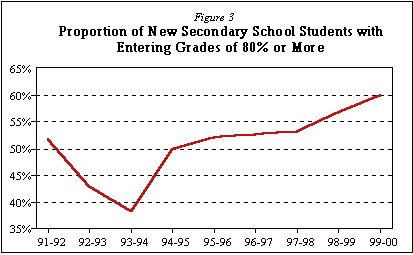
Graduate Student Support. The allocation of 75% of total graduate student tuition revenue (excluding self-funded programs) will continue in 2000-01. Total graduate student support will amount to over $11.6 million in 2000-01.
The 2000-01 budget model includes a number of investment proposals in our Faculties, many directly related to program expansions. The total value of these investment proposals is nearly $1.7 million, with a focus on much-needed faculty renewal — th e Provost has approved over 50 tenure-track faculty appointments to be made in 2000-01.
3. Expansion of the Bachelor of Administrative and Commercial Studies Program
Demand for entrance to the BACS program continues to be very strong. The introduction of new streams and the conversion of the BACS to a four-year program have played a central role in enhancing the program’s reputation. Intake into the program has increased substantially over the past few years, and is being set at 550 for 2000-01. A sum of $100,000 in base budget funds is being allocated in support of the BACS, and funds also have been provided to develop an on-line stream of the program.
4. Expansion of ATOP-based Programs
Western’s programs in Computer Science, Electrical/Computer/Software Engineering, and Media, Information, and Technoculture continue to expand, and are being supported by over $700,000 in direct ATOP funds as well as substantial Enrolment Contingen t Fund (ECF) allocations.
5. Investment in the Faculty of Law
Western’s Faculty of Law is among the national leaders in legal education, as evidenced by its high rankings in the recent ratings by Canadian Lawyer magazine. A sum of $270,000 in base funds is being invested in the Faculty of Law in 2000-01. This investment will provide Western’s Law School with a solid foundation from which to sustain and promote its programs.
Undergraduate and graduate student recruitment continues to be a top priority for Western; a total of $500,000 is being allocated in direct support of recruitment initiatives in 2000-01.
7. Increase to the Library Acquisitions Budget
The acquisitions budget within the Library System is being increased by over $425,000, or 5%, in recognition of the University’s commitment to maintaining and improving a resource vital to all areas of education and scholarship.
The innovative certificate program in writing, introduced in 1998-99 by the Faculty of Arts, continues to expand. The total estimated budget allocation for the program in 2000-01 is $253,000.
9. The Canada Foundation for Innovation (CFI) and Ontario Innovations Trust (OIT) Initiatives
The CFI and the OIT programs, introduced in 1998-99, provide the University with unprecedented opportunities to obtain much-needed funding for the renewal and expansion of infrastructure necessary for resource-intensive research and graduate educat ion. An additional $2.5 million of matching funds is being allocated in 2000-01, bringing the total over three years to $7.5 million.
10. Deferred Maintenance and Instructional Facilities
As recommended in the University’s Strategic Plan, the operating budget commitment to deferred maintenance is being increased by a base amount of $750,000 – bringing the total deferred maintenance base budget to $4.25 million in 2000-01. In additio n to addressing overall deferred maintenance issues, these funds will be used in 2000-01 to fund the improvement of instructional and research facilities across campus.
A sum of $600,000 is being set aside in the Capital Budget in support of general classroom improvements and to enhance technology in many classrooms across campus.
11. Academic Support Initiatives
As an outcome of the annual planning process, many instruction and research related initiatives will be funded from the 2000-01 Provost’s Academic Support Fund (PASF). The range of projects include instructional technology initiatives, new program developments, and faculty development. Total funding for these initiatives amounts to about $1.2 million.
D. Update on Current Year’s Budget (i.e. 1999-2000)
Figures 4a and 4b summarize the changes in the 1999-2000 operating revenues and expenditures -- i.e. the variance between the 1999-2000 revenues and expenditures approved by the Board of Governors in April of 1999, and current estimates of r evenues and expenditures for 1999-2000.
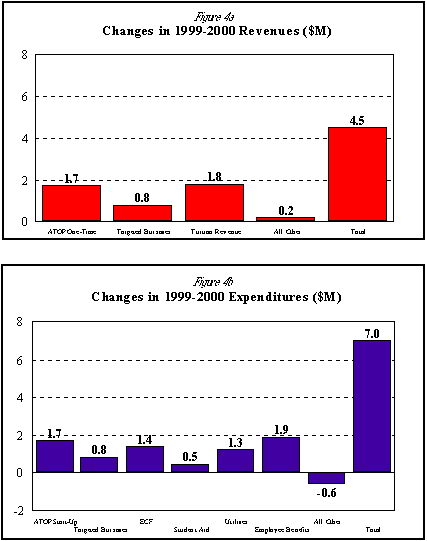
Revenues
Expenditures
Note that the net negative $2.5 million revenue/expenditure variance was more than accounted for by unanticipated increases in utilities and benefit costs.
Total Operating Revenues are projected to increase by 5.6% as shown in Table 1.
The government has introduced two new funding envelopes for 2000-01 – the Accessibility Fund and the Performance Indicators Fund. As stated earlier, the eligibility criterion for the Accessibility Fund will make it very difficult for Western to obt ain a share of these funds, despite the substantial overall enrolment increase anticipated in 2000-01. Discussions with the Ministry are underway aimed at achieving a minor modification of the eligibility criterion to recognize the position of those unive rsities, including Western, where intake increased substantially in 1999-2000. Pending a final resolution, the estimate shown on line 3 of Table 1 assumes that Western will be provided with its share of the fund; if this is not the case, our revenues will be lower by $1.4 million. Note that even if Western qualifies for the Accessibility Fund, this estimate is entirely dependent upon the number of other universities that ultimately qualify and the increase in system enrolment for 2000-01, issues that will not be resolved until late in the fall of 2000. The projected amount from the Performance Indicators Fund is based on most recent indicators data available.
Western’s share of base ATOP funds, targeted at programs in Engineering Science and Computer Science, continues to grow. One-time ATOP funds are provided to cover start-up and infrastructure costs associated with the expanding programs.
As stated earlier, due to a change in government’s distribution mechanism, Western’s share of pay equity grants will be reduced by over $660,000 in 2000-01.
Canadian Students and Permanent Residents. For 2000-01, it is recommended that tuition fees for regulated programs be increased by 2% -- the maximum allowed by government. Recommended tuition fees for 2000-01 for all other programs are shown in Table 10a. The 2000-01 increased tuition fees for Business (HBA) and Dentistry were approved by the Board of Governors, as part of last year’s budget.
Following lengthy discussions with the Faculty of Law, tuition fees for incoming Law students are recommended to be set at $6,400. Students "in program" will be grandparented at a maximum tuition fee increase of 20%. The increase in Law tuition fee lev els is being recommended in the context of special investment in the Faculty of Law, and has the full support of the Dean of Law.
As can be seen in Table 10a, it is recommended that tuition fees in most graduate programs be increased by 1.9%. This increase will leave graduate fees at Western within the same range as competitor universities across the province. Note that 75% of al l increased revenue from graduate student fees is directed back to graduate student support. This approach allows these funds to be used differentially to support students in programs where they are less likely to have access to other sources of funds -- i.e. the Arts and Social Sciences as compared to the Sciences and Engineering. In addition, the allocation of 75% of graduate tuition revenue has provided for substantial bursary funds to support individual students in special need, particularly in Catego ry II graduate programs. This program amounts to an indirect redistribution of support funds in the interest of enhancing access for individual students in financial need, and for students in programs where other sources of financial aid tend not to be re adily available.
International Student Tuition Fees. A set of proposals which rationalized and simplified international student tuition fees was approved as part of last year’s budget, and this recommendation continues for 2000-01. Table 10b shows the recommende d international student tuition fees for 2000-01.
Projected Enrolment Levels. Tuition revenue is determined both by fee rates and enrolment levels. The enrolment projections approved by SUEPP (SCUP’s Subcommittee on Enrolment Planning and Policy) are shown in Table 11. Full-time undergraduate e nrolment is projected to increase by 3.2% in 2000-01 -- as a result of the flowthrough of the higher first-year intakes of recent years, and of expansions in the HBA, Engineering, BHSc, Nursing, Information and Media Studies, and the BACS programs. Full-t ime graduate enrolments are projected to increase by 4.4%.
Tuition Revenues. Overall tuition revenue is projected to increase by 7.4%. A substantial portion of this increase is a result of increased enrolment and fee rates in the MBA programs, revenue that flows directly to these full-cost-recovery prog rams and is not available for general expenditures. Regular undergraduate tuition revenue is expected to increase by 5.9% and graduate tuition revenue is expected to increase by 3.9%.
Major items to note in other revenues include: Affiliate Service Fees, Investment Income, and Contributions from Ancillaries and Other Operations.
As stated in the introduction to this budget document, the recent government announcement on grants and tuition fees resulted in a revenue shortfall of nearly $2.5 million when compared to our original budget planning assumptions. In order to cover thi s shortfall, $2.5 million is being appropriated from the University’s investment funds on a one-time basis. It should be understood that this appropriation is intended to cover the shortfall for 2000-01 only; the ongoing impact will need to be accommodate d within the 2001-02 operating budget.
As noted in past years, this high draw on investment income cannot be sustained in the long run and must eventually be replaced through increased revenue from other sources and/or reduction in operating expenditures. In addition, the need for matching funds from university sources to successfully implement our SuperBuild projects and other necessary capital projects will require support from the investment fund, making these funds much less accessible to the operating budget.
F. Budget Allocations to Faculties
Table 2 presents a summary of the base budget allocations for Western’s Faculties in 2000-01.
As indicated in column b of Table 2, the budget recommendations begin with an initial reduction of 2.0% to all Faculties (except Business: MBA). This initial budget reduction is necessary to cover increasing costs in salaries and inflation. The abs ence of any central recovery of retirement savings in recent years increases the probability of the need for such an annual budget reduction, even given modest increases in revenue.
A series of very substantial selective additional allocations results in an overall allocation to the Faculties that is very nearly the same as in 1999-2000 (see line 21 of Table 2).
2. Selective Budget Allocations
a. Enrolment Contingent Fund (ECF)
A Brief History. The ECF is now a well-established feature of Western’s annual budgeting process and over the past three years has had a substantial differential impact on the allocation of funds across Faculties as a result of shifts in underg raduate teaching and graduate enrolment patterns across campus.
The ECF was introduced in 1997-98 to respond to shifts in enrolment/teaching across the University and to recognize efforts by academic units to attract and accommodate students in their classes, irrespective of their programs of registration. The ECF provides annual funds to the academic units based on growth in Weighted Teaching Units (WTUs) over pre-established baseline WTUs for each Faculty. The baseline for each Faculty is the lower of: (a) the average of the 1994-95, 1995-96, and 1996-97 WTUs or (b) the 1996-97 WTUs. In recognition of recent enrolment/teaching patterns within the Faculties of Arts and Social Science, the ECF baseline for these Faculties was further reduced, providing them with a greater opportunity to receive ECF.
Weighted Teaching Units (WTUs) capture overall teaching activity within the Faculties. WTUs incorporate graduate enrolments from programs residing within each Faculty, undergraduate enrolments in professional Faculties, and undergraduate teaching – whi ch is measured by course registrants, irrespective of the students’ Faculty/program of registration. The specific weights assigned to the various enrolment categories are:
|
First-Year-Level Course Registrants |
0.2 |
(equates to 1.0 per FTE) |
|
General-Level Course Registrants |
0.2 |
(equates to 1.0 per FTE) |
|
Honors-Level Course Registrants |
0.4 |
(equates to 2.0 per FTE) |
|
Education, HBA, Law FTEs |
2.0 |
|
|
Medicine (M.D.) FTEs |
4.0 |
|
|
Medical Residents |
1.0 |
|
|
Dentistry (D.D.S.) FTEs |
4.0 |
|
|
Master’s FTEs |
3.5 |
|
|
Ph.D. FTEs |
7.0 |
|
The following self-funded and full-cost-recovery programs are excluded from WTU calculations: MBA, Executive/Video MBA, International Medical Residents, Faculty of Medicine’s Malaysian Exchange Program, National Dental Examining Board Qualifying Progra m, Additional Qualification Enrolments in the Faculty of Education, and all non-credit programs/courses.
An important feature of the ECF is recognition of cross-Faculty teaching by individual members of faculty. If a course offered by a program in Faculty A is taught by a member of Faculty B (i.e. cross-Faculty teaching), the WTUs will be credited to Facu lty B and an additional 20% of the WTUs associated with the course will be credited to Faculty A.
ECF Allocations in the Current Year (i.e. 1999-2000). Table 9 shows ECF allocations for 1999-2000. Note that the ECF allocations shown in Table 9 are based on a value of $1,250 per incremental WTU.
Conversion of ECF Funds to Base Budget. It has been our intention from the outset that, where changes in enrolment patterns stabilize at higher levels, ECF funding be converted to base operating allocations; such conversions were made in 1999-20 00, as follows: $750,000 for Health Sciences, and $250,000 for Engineering Science.
For 2000-01, it is being recommended that an additional $1.75 million of ECF funding be incorporated into Faculty base budgets, as follows:
|
Engineering |
$ 300,000 |
|
Health Sciences |
$ 400,000 |
|
Information & Media Studies |
$ 150,000 |
|
Medicine |
$ 100,000 |
|
Music |
$ 50,000 |
|
Science |
$ 500,000 |
|
Social Science |
$ 250,000 |
|
Total |
$1,750,000 |
** The $300,000 being allocated to Engineering includes $50,000 associated with the application of ECF rate increase to the amount converted to base in 1999-2000. Similarly, the $400,000 being allocated to Health Sciences includes $150 ,000 associated with the application of ECF rate increase to the amount converted to base in 1999-2000.
Column f in Table 2 shows the $1.75 million dollars in ECF funds which are being incorporated in Faculty base budgets. With this conversion of ECF funds to base budgets, there will be a corresponding increase in the ECF baselines for the appropr iate Faculties. In interpreting column f, it is important, therefore, to remember that in all cases base budget transfers will be offset by a reduction in ECF for 2000-01 relative to that which otherwise would have been allocated; in some cases these base budget transfers may reduce ongoing ECF funding in 2000-01 below the 1999-2000 level. Current estimates of 2000-01 enrolments and the associated ECF funds indicate that such an offset will occur in four Faculties: Health Sciences, Information and Media S tudies, Music, and Science. As line 17 of Table 2 shows, the estimate of ongoing ECF for 2000-01 (excluding the amounts converted to base budget) is $4.5 million, about $400,000 more than the amount in 1999-2000. In line 21, which adds ECF and SFRI to the Faculty base budgets in line 16, total Faculty budgets decrease by about $34,000.
An Increased Unit Value in 2000-01. The mechanism used to allocate ECF funds was consciously designed on a "rough justice" model, i.e. it is understood that the real costs of expansion in enrolment varies substantially across courses, ranging fr om a low cost where capacity exists in class sections already mounted to the much higher costs of opening additional sections of courses that include laboratories or small groups with essay grading requirements. Since the ECF program was first implemented , many Deans have argued on behalf of their Faculties that this approach did not provide adequate recognition of expansion at the higher cost end of this spectrum. These arguments were raised once again in the current planning cycle. Rather than wrestle w ith the inevitable and endless debate that would be involved in establishing a differential ECF value across courses, it is being recommended that the ECF value for all courses/programs be increased by 20% to $1,500 per incremental WTU. Given that every F aculty more or less experiences enrolment shifts across the full cost spectrum of courses, this increase should provide the increased funding for expansion in higher cost courses sought by many Deans, Chairs, and Directors.
Enrolments and Teaching Activity. Enrolments, teaching activity, and WTUs have changed at very different rates over the past decade. During the severe budgetary stringency of this period, all Faculties have been hard-pressed to manage their budg ets and teaching requirements. The graphs in Appendix B show changes in WTUs over the last decade. The Faculties are distributed into four groups according to the value of WTUs in 1999-2000, shown on the vertical axis.
b. Faculty-Specific Allocations
Faculty of Arts. Western’s Faculty of Arts maintains its position among Canada’s foremost teaching and research units and is working determinedly to restore enrolment levels in its fine undergraduate programs.
The Richard Ivey School of Business. The final phase of the MBA transition to full-cost-recovery status takes place in 2000-01. As approved in last year’s budget, the HBA program has been expanded by an additional section. The new section will r each steady-state in 2000-01. The Ivey programs continue to hold a leadership position in business education as evidenced by Ivey’s ranking as Canada’s best business school and 19th among the world’s best business schools in the recently-releas ed rankings by the Financial Times of London.
Faculty of Education. The Faculty of Education’s B.Ed. enrolment increased substantially in 1999-2000, and was supported through additional base budget allocations. The Faculty has also expanded its graduate program offerings through the introdu ction of a stand-alone Ph.D. program and is collaborating with three other Ontario universities on a joint Ph.D. program in Educational Studies.
Faculty of Engineering Science. The Faculty continues to expand as a result of the government’s ATOP initiative — increased funding is provided through direct ATOP grants as well as ECF. Engineering has also been successful in early CFI/OIT comp etitions and is expected to submit additional applications to the upcoming competitions.
Faculty of Graduate Studies. The Faculty of Graduate Studies oversees all graduate programs at Western and has played a leadership role in the strategic expansion of enrolment at the graduate level in recent years. Additional administrative load in FGS is being met by funds arising from a variety of sources, including the administrative component of the 30% student support tuition set-aside and interest on national scholarship funds now administered locally.
Faculty of Health Sciences. Enrolments in the BHSc program, introduced in 1997-98, continue to approach steady-state levels. The Nursing program was also expanded in 1999-2000 and continues to attract high quality students. Substantial ECF funds are being allocated in support of the growing enrolments. The Faculty of Health Sciences also has been successful in early CFI/OIT competitions and is expected to submit additional applications to the upcoming competitions.
Faculty of Information and Media Studies. Enrolments in the MIT program, also introduced in 1997-98, continue to approach target steady-state levels and are being supported by substantial allocations from the ECF. The Faculty is also in the proc ess of introducing new graduate courses in distance format.
Faculty of Law. Western’s Faculty of Law is among the national leaders in legal education, as evidenced by its high rankings (number 2 in Ontario and number 6 in Canada) in the recent ratings by Canadian Lawyer magazine. The recommended budget i nvestment of $270,000 in 2000-01 recognizes the need to invest in the Faculty, especially in view of investments in other Ontario programs with funds arising from increasing tuition fees. This investment will provide Western’s Law school with a solid foun dation from which to sustain and promote its programs.
Faculty of Medicine & Dentistry. The School of Dentistry is continuing with a five-year plan which includes revenue generation through increases in international student enrolments, clinic activities, and continuing education offerings. As p art of this five-year plan, $80,000 in base budget funds is being allocated to support faculty appointments.
As indicated in the University budget document for 1999-2000, Western’s Faculty of Medicine & Dentistry is among our most important cornerstones in resource-intensive research and professional education. As tuition fees for its programs increase, i nvestment is necessary to sustain the quality of its programs and its competitiveness in the province and the country -- the proposed selective allocation of $200,000 in 2000-01 responds to this imperative and will be used to support the Faculty’s success ful initiatives in early CFI/OIT competitions and to enhance future proposals in upcoming competitions.
Faculty of Music. The Faculty of Music is a national leader in music education, offering a full range of undergraduate and graduate programs, attracting high quality students. Recent increases in enrolments and teaching activity are being suppor ted by ECF and the conversion of ECF to base budget.
Faculty of Science. The Faculty’s teaching responsibilities continue to increase substantially -- primarily due to the ATOP expansion in Computer Science and Engineering. These expansions are being financially supported through direct ATOP grant s as well as ECF. The Faculty of Science has also been successful in early CFI/OIT competitions and is expected to submit additional applications to the upcoming competitions.
Faculty of Social Science. The introduction of new streams in the BACS program and its conversion to a four-year program have played a central role in enhancing enrolments/teaching in the Faculty — the increased teaching activity is being suppor ted by substantial allocations from the ECF. The Faculty is planning to introduce a new stream of the BACS in distance education format. A sum of $100,000 in base budget funds is being allocated to support this new initiative which will further enhance th is successful program.
The PASF continues in 2000-01 and is being allocated to specific instructional and research initiatives within the Faculties. Table 12 outlines the initial recommended 2000-01 PASF allocations, which are all one-time funds. Other academic initiativ es will be considered for PASF funding during the year. For information, a detailed accounting of the PASF for 1999-2000 is shown in Table 13.
Base budget allocations for student support are shown in Table 3. Overall student support funding is being increased by over $1.5 million for 2000-01. The cumulative impact of this 7% increase in funding is shown in Figure 5, and reflects We stern’s continuing commitment to the financial support of graduate and undergraduate students. Total student support funding has increased from $4.9 million in 1992-93 to $24.1 million in 2000-01.
The base budget for undergraduate scholarships is being increased by $150,000, reflecting the projected increase in scholarship-eligible first-year students.
2. Needs-based Undergraduate Student Support
Funding for needs-based student support, generated through the 30% required set-aside of tuition, is expected to increase by over $890,000 in 2000-01 to a total of about $8 million. These funds will be allocated to students in financial need throug h the University’s work/study program and direct needs-based bursaries.
The needs-based student support funds resulting from the tuition set-aside will be supplemented by other funding sources, including donations and special programming funding from the government – and will be distributed by the Financial Aid Office acco rding to prescribed criteria.
Under the government’s guidelines for the disposition of tuition set-aside funds for student financial aid, 5% will be used to cover the administrative costs of the service.
There will be an addition of over $320,000 to overall graduate student support as a result of allocating 75% of graduate student tuition revenue (excluding self-funded programs) back to graduate student support. Total graduate student support now a mounts to over $11.6 million.

H. Budget Allocations to Support Units
Base budget allocations to support units for 2000-01 are shown in Table 4. The allocations reflect differential decisions involving investment in areas of priority. It is important, however, to recognize that this flexibility indirectly deri ves from the initial budget cuts made to the support units. The need to adjust to this initial reduction will place additional pressures on staff members who already are carrying a workload that has increased substantially as a result of the budget reduct ions of the past decade and that cannot be sustained indefinitely.
Table 5 summarizes Corporate Expenditures, which are central operating expenditures that extend across all areas of the University.
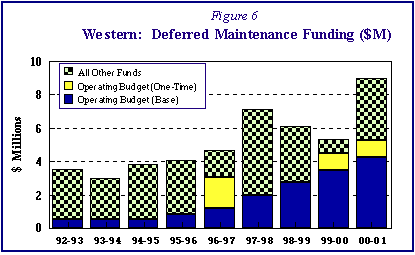
J. One-time Allocations
One-time allocations for 2000-01 are shown in Table 6 and amount to a total of over $11.8 million. These allocations include targeted funding for specific initiatives critical to the functioning of the University.
Table 7 provides a summary of the University’s Operating Budget for 2000-01. Line 7 shows the provision of an additional $5.5 million in support of anticipated cost increases. This amount is the net result of provision for employee salary in creases and benefit cost variations.
The projected year-end positions for 1999-2000 and 2000-01 are shown in line 15. In the current year (i.e. 1999-2000), a deficit of $1.4 million is expected – primarily due to unanticipated increased costs in the areas of employee benefits and physical plant utilities. The year-end projection for 2000-01 is a surplus of $3 million, which is required to offset the previous year’s deficit and to replenish, in part, the Operating Reserve. The Operating Reserve, summarized in Table 8, is projected to be at $2.1 million in 2000-01, $400,000 below the Board-mandated level of $2.5 million.
Two worrisome aspects of this budget must be underscored. First, the revenue from the Accessibility Fund (shown in line 3 of Table 1) will not materialize if Western’s first-year intake in the fall of 2000 does not equal the high-water mark of fall 199 9. In the absence of this revenue, the projected 2000-01 Operating Reserve will be reduced to $700,000 from the $2.1 million shown in Table 8. Restoring the Operating Reserve to $2.5 million will add to the challenges of the 2001-02 budget planning proces s. Second, the projected Operating Reserve of $2.1 million is achievable only as a result of the exceptional one-time appropriation of $2.5 million from our investment funds (shown in line 27, Table 1). This step is a one-time solution to a base budget sh ortfall that will need to be addressed in the 2001-02 operating budget, most likely by way of additional reductions to the allocations to Western’s Faculties and support units.
Finally, it should be noted that, in 1999-2000, the University operating budget units collectively overspent their budgets by about $2 million. Figure 7 shows historical carryforward/overspending patterns. The overspending in 1999-2000 reflects the cum ulative impact of budget reductions over the past decade.
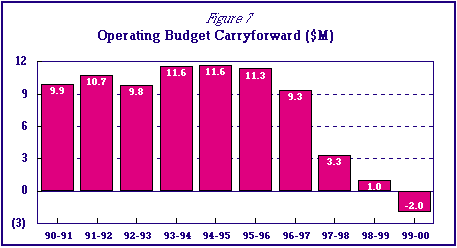
The annual planning process for 2000-01 included both a sharp focus on the immediate challenges of the year 2000-01, and the opportunities and challenges of the longer term. As documented here, at least for the present time, the government f unding/tuition announcement can only leave us with a sense of disappointment regarding the short-term, and of mounting anxiety concerning Western’s ability to maintain quality and access in the longer run. Our only course must be to accept the sincerity o f the Government of Ontario’s commitment to maintain access to the province’s universities for every qualified and motivated student, and to assume that the government understands that such access is meaningless unless the quality of our programs can be m aintained and enhanced.
It goes without saying this challenge of quality and access is brought into stark relief by the anticipated unprecedented increase in demand for university places in Ontario. The recent funding/tuition announcement makes it clear that we have failed to communicate effectively our message to the government. Western cannot expand to meet this demand on the basis of BIU funding for additional students that is a fraction of that which has left Ontario’s universities with student/faculty ratios that are ove r 20% higher than the average in all other provinces, and that excludes graduate students. Our objectives overlap with those of the Ontario government -- to maintain access to a quality education. We are not adversaries in pursuit of this common goal and we must redouble our efforts to reach a common understanding of both the public policy objectives that are at stake here, and of the approach necessary to achieve those objectives.
Appendix A
The University of Western Ontario
Report on The 1999-2000 Quality Improvement Plan
Since 1998-99, the Ontario government has called upon universities to report annually on the manner in which tuition fee increases enhance the quality of education for students and provide for expansion in areas of high student demand. Last year’s oper ating budget document included a section on Western’s Quality Improvement Plan. This appendix provides an update on that plan, using the same categories as last year’s budget document.
1. Student Support
Tuition Set-Aside for Needs-based Student Aid. Last year’s budget indicated that an additional $2.3 million would be set aside in 1999-2000 for needs-based graduate and undergraduate student support. The actual additional allocation in 1999-200 0 was over $2.4 million. We are committed to ensuring that qualified students are able to enter and continue their studies at Western irrespective of financial circumstances.
Undergraduate Scholarships. Last year’s budget indicated that an additional $166,000 would be set aside in 1999-2000 for undergraduate scholarships. The actual additional allocation in 1999-2000 was $366,000. The quality of Western’s incoming fi rst-year students continues to increase.
Graduate Student Support. Last year’s budget indicated that graduate student support in 1999-2000 would total over $11 million. The actual graduate student support budget in 1999-2000 was over $11.3 million.
2. Faculty Renewal
Last year’s budget indicated that, as part of the various budget investments in our Faculties, over 50 tenure-track faculty appointments for 1999-2000 had been approved by the Provost. In 1999-2000, 56 new tenure-track faculty appointments were made at Western. Searches are continuing for other unfilled positions.
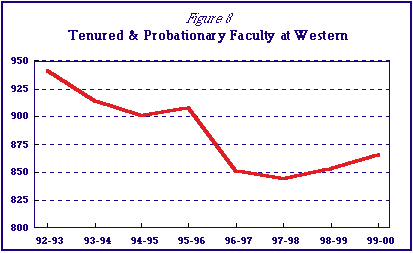
3. Expansion of High-Demand Programs
Honors Business Administration (HBA). Last year’s budget indicated that $600,000 in base funds were being allocated in support of an additional section of the HBA. The new section was added in 1999-2000 and the base budg et allocation was made -- and was supplemented by an additional $100,000 allocation from the Provost’s Academic Support Fund.
Computer Science. As indicated in last year’s budget, the ATOP-related expansion in Computer Science continues and is being supported by direct ATOP funds as well as allocations from the Enrolment Contingent Fund (ECF). Full-time en rolment in Computer Science increased by 29% in 1999-2000.
Education. As indicated in last year’s budget, in response to a request from the Ontario Government, B.Ed. enrolment at Western was increased by 114 in 1999-2000 – and supported by a base allocation of $200,000 as well as ECF funds.
Electrical/Computer/Software Engineering. As with Computer Science, the ATOP-related expansion in Engineering continues and is being supported by direct ATOP funds as well as allocations from the Enrolment Contingent Fund (ECF). Ful l-time enrolment in ATOP-based Engineering programs increased by 23% in 1999-2000.
Nursing. As indicated in last year’s budget, intake into the Nursing program was increased to 87, and was supported by ECF and a supplemental allocation of $20,000.
Expansion of Four-Year Degree Programs. As indicated in last year’s budget, the BACS program was converted to a four-year program, and in its first year, over 60 students initially registered in the 3-year program opted to continue into the 4th year rather than graduate with a 3-year degree. The program was supported through the allocation of ECF funds.
4. Investment in the Faculty of Medicine & Dentistry
Budget investments in our Medical and Dental Schools were proposed in last year’s budget. The proposed investment in Medicine was $462,800 in base funds. The actual allocation was $462,800 in one-time funds. In addition, $500,000 was set aside as part of a 10-year plan to fund the renewal of facilities in the Medical Sciences Building. The proposed investment in Dentistry was $200,000 in base operating funds and $500,000 for capital expansion of Dental School facilities. Both of these com mitments were carried out. The Dental School facilities project is currently in the design stage and the operating budget investment will be used to support new faculty appointments.
5. Investment in the Faculty of Engineering Science
Consistent with the recommendations in Western’s Strategic Plan, a budget investment of $200,000 in the Faculty of Engineering Science was proposed in last year’s budget. This investment is being used to support program expansions by addi ng new faculty and staff positions.
6. Student Recruitment
The budget investments in support of student recruitment initiatives continue to be effective, and is reflected in the increases in the entering grades of incoming students.
7. Increase to the Library Acquisitions Budget
As indicated in last year’s budget, the Library Acquisitions budget was increased by over $400,000 in 1999-2000. This is an area of high priority for the university, and further increases are proposed for 2000-01.
8. The Writing Program
The budget allocation for the Faculty of Arts’ innovative Writing Program recommended in last year’s budget was made. In 1999-2000, the Writing Program offered a total of 46 course sections -- with a total course registration count of ove r 520.
9. The CFI and ORDCF Initiatives
The University’s allocation of $2.5 million as CFI/ORDCF "matching" funds has been crucial in Western’s successes in the early rounds of the CFI competitions. The University was successful in receiving major CFI awards in the areas of Aud iology, Biomedical Engineering, and Advanced Biotechnology.
10. Deferred Maintenance and Instructional Facilities
As recommended in last year’s budget, the University’s operating budget commitment to deferred maintenance in 1999-2000 was indeed $3.5 million. These funds were used to address overall deferred maintenance across campus and were used to renew instructional facilities in Somerville House, Talbot College, Elborn College, Social Science Centre, and University College.
11. Academic Support Initiatives
As noted in last year’s budget, numerous instruction and research related initiatives were funded from the Provost’s Academic Support Fund (PASF), and total funding for these initiatives amounted to $1.5 million. Examples of such initiatives in clude:
Appendix B
The University of Western Ontario
WEIGHTED TEACHING UNITS (WTUs)
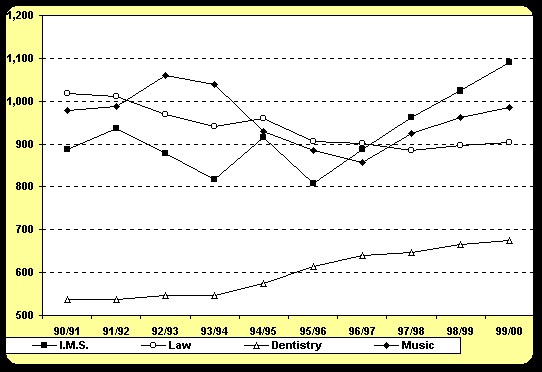
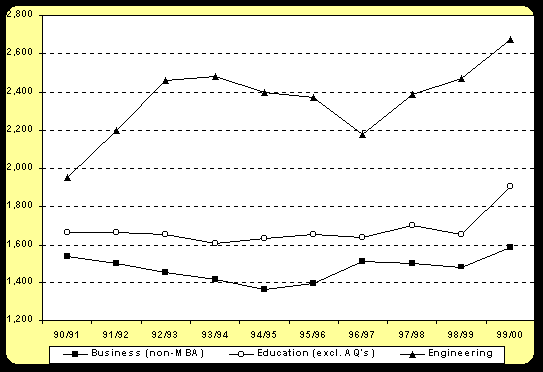
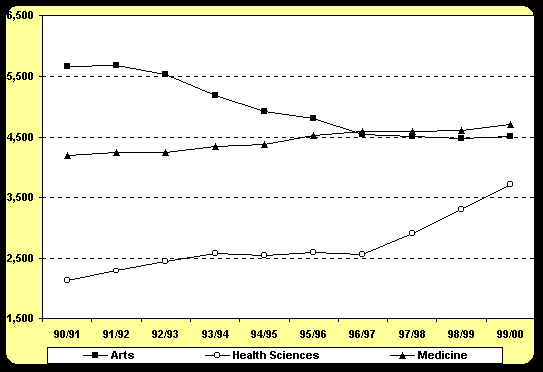
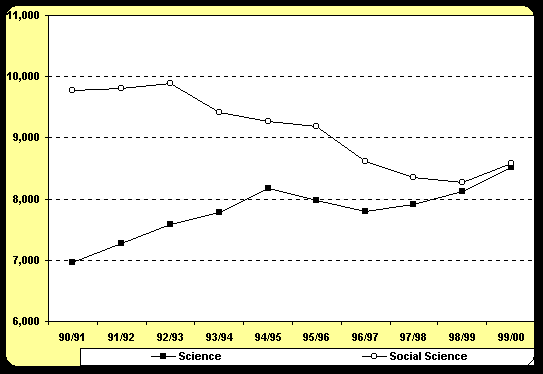
Appendix C
Revenues, Expenditures, and Tuition Fees by Faculty
The graphs below summarize revenues, expenditures, and tuition fees by Faculty using the basic methodology developed in Looking Forward (April, 1996). The details of the methodology have been revised considerably since the 1996 version, as follo ws:
In the analysis below, revenues include tuition and the grant revenue which can be attributed to each Faculty by the MTCU’s BIU system of grant allocation. Figure A compares expenditure less revenue, by Faculty, for 1995-96 (shown in grey patter n) with data for 1998-99 (shown in black). The Faculties shown in the graph are Arts; Science; Social Science; the subtotal of those three Faculties; Business; Medicine and Dentistry; and the total of the following six Faculties: Education, Engineering, H ealth Sciences, Information & Media Studies, Law, and Music. Because Western does not subscribe to the BIU system of weights, we do not aspire to an equality between expenditure by Faculty and the revenues which can be attributed by the BIU system.
Nonetheless, these figures in Figure A are important because it is sometimes asserted that universities with "professional" schools use revenues from those schools to "subsidize" the liberal arts and sciences, and that therefore grant funds should be t ransferred from those universities with significant professional schools to the other universities. This assertion has no foundation, as Figure A indicates. Using the BIU system to allocate grant revenue, in 1995-96, there was a net transfer from Arts, Sc ience, and Social Science of $22.5 million to the other Faculties; in 1998-99 that net transfer has declined to $5.6 million, because of differential changes in tuition fees and budget allocations.
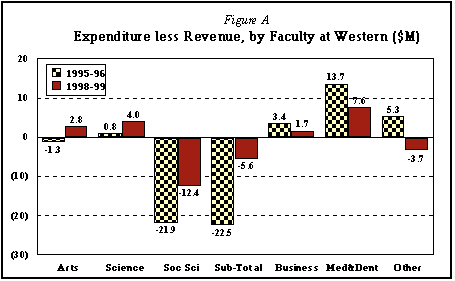
Those in our province who argue that "professional" schools "subsidize" the liberal arts and sciences are simply wrong. If there is such a "subsidy", it goes from the liberal arts and sciences to the other disciplines, and while that impl icit "subsidy" has declined over the last two years at Western it is still quite large. Any suggestion that MTCU should tax the grant to Western on the grounds that our professional schools are subsidizing the liberal arts and sciences is entirely unaccep table.
Figure B shows tuition as a percent of cost, by Faculty, for 1998-99. The figures range from a high of 48.3% for Social Science to a low of 11.7% for Medicine. Because of differential changes in tuition fees and budget allocations, these figures have also changed since 1995-96.
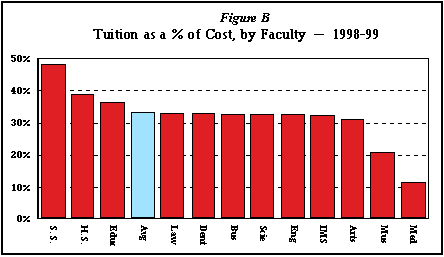
It has been suggested that the cross-Faculty teaching cost allocation (i.e. the $400 per full-course-equivalent course registrant or $28,000 for a full course of 70 students) is inadequate. Even if the service teaching cost were to be doubled, to $800 per course registrant, the impact on the data in Figure B is minimal – with Social Science dropping to 46.9% and Medicine increasing to 12.2%.
![]() Back to UWO Documents and Data Page
Back to UWO Documents and Data Page
UWO-IPB
Dated: 2000/05/18